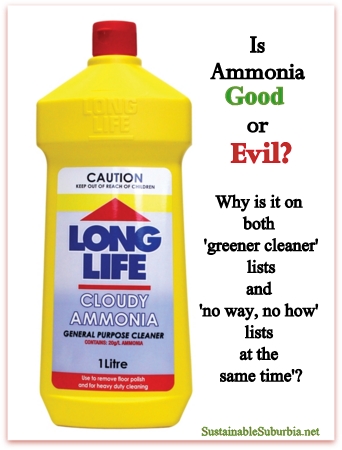 Lots of the “green cleaning” books I have been studying over the past year recommend ammonia.
Lots of the “green cleaning” books I have been studying over the past year recommend ammonia.
And, fact sheets on grey water recommend ammonia.
But healthychild.org, among others, say to steer well clear.
So what’s the go? Should we be using ammonia in our DIY cleaning products or not? Well, I’ll come to that in a minute. But firstly —
What is ammonia?
Ammonia is a common ingredient in both commercial and DIY cleaners. It is also used to produce fertilisers, plastics, synthetic fibres, dyes and pharmaceuticals.
Household ammonia, bought in the cleaning section of the supermarket, is really a solution of water with 5-10% ammonium hydroxide. Cloudy ammonia is the same thing with a little soap added. Through the rest of this article, when I talk about using ammonia, you can take it as read that I’m talking about that 5-10% solution.
Fact: Ammonia is toxic to humans. Of course, so is dish washing liquid. And tea tree oil. So the simple fact that it is toxic doesn’t necessarily mean we need it out of our house. But, ammonia is more toxic than dish washing liquid, and if you decide to use it, you will definitely want to keep it right out of the reach of children.
So how harmful is ammonia then?
According to the UK’s Health Protection Agency’s (HPA) Compendium of Chemical Hazards (PDF, 260 Kb) “Minor exposures may result in a burning sensation of the eyes and throat and more substantial exposure may cause coughing or breathing difficulties.” Very high exposure can fatal. Keep in mind that they are generally referring ammonia gas or pure ammonium hydroxide rather than the 5-10% solution you would normally buy for cleaning, but the risks are still there.
If splashed on the skin, liquid ammonia can cause burns, and should be immediately washed off with soap and lots of luke warm water.
If ammonia is ingested, it can burn the mouth, throat and stomach. It may be comforting to know that it doesn’t normally result in systemic poisoning though! (Source: NY Department of Health). If ammonia is swallowed it is usually diluted with milk or water (but if that happens, don’t just rely on that, call the poisons hotline!).
If you mix ammonia and chlorine bleach, they will produce the far more toxic chlorine gas. Don’t risk it. Don’t ever use them together, and if you have recently used chlorine bleach or bleach containing detergents in your washing machine, make sure both the machine and the clothes have been washed again before washing with ammonia. Note that oxygen bleach has no chlorine, and is fine to use with ammonia.
Ammonia is not thought to be a carcinogen.
Safety precautions
When using ammonia it’s best to wear rubber gloves and work in a well ventilated space. Don’t use it around children or pets, who may be more sensitive simply due to their size. According to the HPA, there is no evidence of damage to an unborn child though, if the mother is exposed at levels that won’t hurt her.
If you have asthma or another chronic respiratory condition I would recommend avoiding ammonia altogether, but if you are going to use it, wear a protective mask.
Keep all ammonia or ammonia containing products well out the reach of children. Always label any homemade cleaning products with all ingredients.
Is Ammonia bad for the environment?
When it comes to the levels in your homemade cleaning products, the answer is no. This is why ammonia is usually included in “green cleaner” lists.
While the large amounts of ammonia resulting from the decomposition of animal wastes in agriculture arguably are bad for the environment, not to mention the huge amounts of nitrogen fertiliser used in large-scale agriculture, the levels in most home cleaning products are considered safe for grey water systems. In fact, the University of Massachusetts fact sheet ‘Recycling Grey Water for Home Gardens’ explicitly says “When doing your household cleaning, use ammonia, or products that contain ammonia, instead of chlorine as the cleaning agent.” (Sources: Environment Agency (UK) fact sheet (PDF 603 KB); University of Massachusetts factsheet on grey water)
Ammonia is a natural part of the ‘nitrogen cycle’ and is produced in soil from normal bacterial processes, so it is commonly found in soil even when fertiliser hasn’t been applied. It is also produced naturally from the decomposition of plants, animals and animal wastes. If you have chickens or an indoor cat, you will probably recognise the smell of ammonia!
Again, at high concentrations it can be damaging, particularly to aquatic life. But at the levels you would usually use in your laundry, it breaks down quickly.
How does Ammonia clean?
The short answer is: quite effectively.
When it comes to green cleaners, Ammonia is really the queen. It’s effective against a range of ills, and though I hate to say it, it really is more effective than many less toxic options like vinegar.
Ammonia is a base which, like lye, reacts with oils and fats to form soap. The water in house hold ammonia then washes the soap away. So it’s good for cleaning things that are oily, whether that’s a window or an item of clothing. When it comes to windows and tiles, it leaves a streak free surface, because what’s left after the reaction is ammonium hydroxide, which will completely evaporate.
Of course, vinegar also makes a good glass cleaner, especially when mixed with rubbing alcohol, water, and – I kid you not – a little corn flour. (See Crunchy Betty for the recipe plus the most entertaining battle of the non-toxic glass cleaners.) I have also read that four parts water to one part vinegar and a little dishwashing liquid (which will help remove any build up from previous commercial cleaners) makes a good glass cleaner (so basically, my DIY spray ‘n’ wipe recipe), but I haven’t tested it yet. Unless you count letting my three year old clean the windows. Which— probably you shouldn’t.
Of course, a high quality microfibre cloth designed for glass cleaning – like the Norwex Dynamic Duo – works just as well as as ammonia on glass, and better than vinegar, without using any chemicals, and also without consumables (except water).
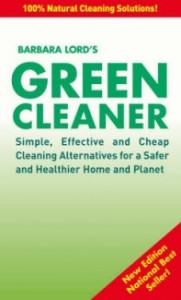 Ammonia also neutralises acids, which is why it is effective against acid based stains like tea, coffee and juice. I have found the Ammonia & dish-washing liquid based spray-on stain remover from Barbara Lord’s Green Cleaner to be as effective as a store bought pre-wash stain remover like Preen. (See down the bottom of my natural laundry stain remover post for the recipe.) That’s really the only thing I do use Ammonia for, but Readers Digest (for instance) has a long list of other uses.
Ammonia also neutralises acids, which is why it is effective against acid based stains like tea, coffee and juice. I have found the Ammonia & dish-washing liquid based spray-on stain remover from Barbara Lord’s Green Cleaner to be as effective as a store bought pre-wash stain remover like Preen. (See down the bottom of my natural laundry stain remover post for the recipe.) That’s really the only thing I do use Ammonia for, but Readers Digest (for instance) has a long list of other uses.
Because it’s alkaline, don’t use any recipes that tell you to store ammonia mixed with a lot of vinegar – they will neutralise each other, just as vinegar and bicarb soda (baking soda) do, and you will be left with a salty solution. Sometimes mixing an acid and base can provide a good cleaning reaction in the moment – bicarb and vinegar are often used together this way. But you cannot store them mixed together (though see note below for an exception to this).*
So, is it good or evil? Should you use it?
I know, I started with this question, and I think the answer is clearly – it’s complicated.
It’s an effective alternative to harsher chemical cleaners, especially things like chlorine bleach. And I’d far rather use a homemade cleaner with ammonia in it than a store bought cleaner with who knows what.
Environmentally it’s fine.
But, if you have a respiratory disorder, you should probably steer clear. Whether you want to have it around your kids or pets (if you have them) is your call. I personally wouldn’t use it to clean floors, for instance, since both my kids and my cat spend a lot of time there, though if you did it while they’re out and it’s dry by the time they get home, it’s probably fine really.
What do you think? Would you use ammonia in your home?
Get Your Free Printables
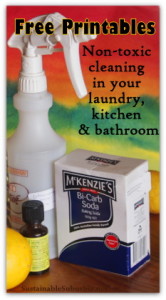 If you’d like my standard set of non-toxic cleaning recipes for your laundry, kitchen & bathroom, including two pre-wash stain remover sprays for the laundry, sign up to get my new Non-toxic Cleaning Printables.
If you’d like my standard set of non-toxic cleaning recipes for your laundry, kitchen & bathroom, including two pre-wash stain remover sprays for the laundry, sign up to get my new Non-toxic Cleaning Printables.
What’s so great about these Free Printables? They’ll make your life easier, because
- You’ll save money on commerical products
- You’ll reduce your family’s exposure to toxic chemicals
- There a bonus page of stain removal tips, and
- No more googling everytime you need to make more laundry detergent!
Put them on your laundry wall, or inside your pantry cupboard. Plus, you get bonus updates of the recipes and the occasional subscriber only emails.
So what are you waiting for? Go get ’em!
______________
*Note: you can store an alkaline solution, like a baking soda mix, with a little bit of vinegar mixed in – the vinegar reacts with a tiny bit of the baking soda to produce a salt solution, which can actually help keep your dirt particles and hard water minerals in solution (rather than having them settle back on your clothes). But, if you add a little bicarb to your vinegar, you will be left with just salty water, since vinegar is generally only a 5% acid solution, whereas bicarb soda is pure base.


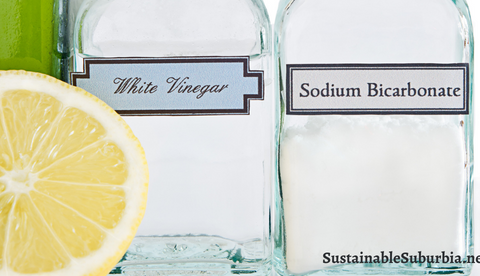
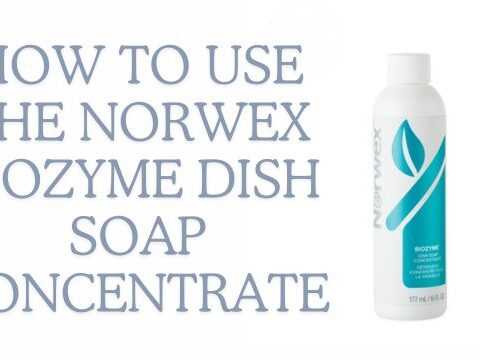

Thanks Kirsten, a very informative post. At this point I wouldn’t use ammonia because of the kids (and I’m not too fussed about stains) but I’ll file this away for future use.
You’re welcome Linda
This is the worst site I have seen… All tell you NOT to use Ammonia around children at all because there respiratory is not strong enough to handle it… You may as well be smoking around your child… It’s do less harm.
Don’t know where this person got there information but they should be Charged with negligence.
Thanks for your trolling Scott. As I said “Don’t use it around children or pets, who may be more sensitive simply due to their size. ”
Sources are in the article….
Very good article. I used it for such a long time and then some misinformed glown at work mixed it with bleach so it would “clean” better. After that incident I have always been a little gun shy.
Yes, I can understand why!!
Old fashioned remedy with what was “Scrubbs Cloudy Household Ammonia” For insect bites such as midge or some mosquito. and drip on cotton wool and dab it on the bite, gets rid of the inflammation and itchiness. Take care with open bites (too much scratching)… I’ve never known it to be harmful… but it can sting for a minute or so.
Anyway it worked for me as a kid, for my children and, today, for the grandchildren.
Ammonia forms into vapor at room temperature and it effect your nostrils and lungs. When it is dissolved in suitable solvents it is the master in application as fertilizer, cleaning agents and coloring agents. It depends on use how we use it rather than ammonia itself.
Hi I have read this informative article wit interest. I have a Biolytix waste water system. This system has a biopod which uses worms to break down the solids in our waste water. Do you have any information on the use of Cloudy ammonia in waste systems such as this?
Thanks
I’m not sure Peggy, I don’t know anything about your system, but I’d be cautious about using it if it’s going to get to the worms quickly. Once it’s had time to break down it might be fine, but as ammonia, I suspect they wouldn’t like that!
I use ammonia for one thing, and that’s my bathroom. The toilet and floor. I have 4 kids, the oldest 3 are boys, and they’re young… they have terrible aim if you know what I mean. I have tried every single organic, DIY, or relatively safe cleaner out there. It’s the only thing that gets rid of the smell, and yellow color on the grout. I wipe down the bathroom daily with hot water and Castile soap, then once a week I soak it for 15 mins in a ammonia/water combo, then scrub and wipe. Household ammonia is already super diluted, it’s considered a weak solution, and by diluting it again at a 1:2 ratio I figure it’s sorta tame at that point. I also open the window and use a box fan during and for awhile after, for fumes. That being said, once the kids are bigger I’ll be glad to rid myself of it. Although bleach makes me feel sick for days, and ammonia doesn’t bother me if the room is well ventilated.
Many years ago Heloise Hint’s wrote a Spray and Wash recipe: 1 part ammonia, 1 part liquid laundry detergent, 1 part water.
A gentler combination may be to substitute “Dawn” for laundry detergent.
After using this cleanser or just plain ammonia, I always spray a rinse of vinegar, it removes slippery residue that can attract soils.
Looking at a possible link between C/Ammonia usage and parkinson’s disease.. My mother used it most of my life and now has parkinson’s.. any relevent stories / experiences would be appreciated
I haven’t heard of a link at all Carly, but I will keep you in mind as I am reading – I’d be interested in hearing about your research too. I’ve really only seen it linked to lung conditions such as chronic bronchitis and asthma in my research.
Hi, do a google search on Parkinson’s disease. Coconut oil unclogs the synapses in the brain and reverses dementia, Parkinson’s and Alzheimer’s and MS. You can get high strength capsules from the vitamin section in the supermarket. Zeolites also have great results for Parkinson’s. try zeolitesfordetox.com. you can buy them for human consumption from Waiora. feel free to contact me for more information. Zeolites carry out heavy metals and toxins and some websites also say free radicals, so people with a wide variety of ailments including cancer have had great success. my email is lightangel8@hotmail.com
Ammonia works VERY good, saving both time and money. I
f you read the New York article carefully, ammonia has an excellent early warning… it’ll take your breath away! So as long as you have common sense and use it in lower concentrations… you will be fine. I’ve done a lot of cleaning with ammonia and haven’t had any ill effects
Great article! It answered my questions about the environmental impact of using ammonia in cleaning solutions perfectly. I use ammonia in cleaning solutions, but at such a low concentration, it hasn’t been much of a concern for an asthmatic like me. I recommend no more than a 10% concentration in any recipe. I still get great results.
I HAVE BEEN USING LEMON AMMONIA IN KITCHEN & BATHROOM. THEN I COULDN’T FIND LEMON AMMONIA SO I BOUGHT STORE BOUGHT CLEAR AMMONIA. I HAD DEVELOPED A VERY CHRONIC COUGH & TROUBLE BREATHING SPURTS NEVER THINKING IT COULD BE FROM AMMONIA. I WENT TO DR & SHE MADE ME GO FOR CHEST X-RAY. ALL CLEAR BUT ONCE I COUGH IT’S CONTINUOUS & CHOKING.
Hi S Wilhelm – I am not a doctor, but my advice would be if you have a cough, to stop using Ammonia, regardless of what has caused the cough in the first place.
I use non-sudsing ammonia on my bathroom and kitchen floors, it was recommended by the company that installed the flooring. It has not stripped off the shine! I also use it diluted with water in a Swiffer type mop.
Good article. It’s natural to be concerned when something is listed as being toxic. As you point out, lots of things are toxic when they’re concentrated and harmless when they’re not. The odor from ammonia based household cleaner is the same sharp odor that you smell from wet diapers that have been left in the bin for a while.
I used to work in a refrigeration plant that used liquid ammonia as the refrigerant. This is nothing like the level of ammonia that you get in glass cleaner.
We had several large tanks of liquid ammonia, about a dozen big industrial ammonia compressors and innumerable pipes, valves, cooling coils etc. Of course there were often smells from minor leaks and some maintenance tasks involved enough of it to be uncomfortable. Being concerned for my health, I did enough research on it to reassure myself that, for a healthy person, an ammonia smell that you can easily tolerate is harmless.
The refrigeration contractors were used to it and could work in concentrations that would send me out of the room.
Bottom line: why pay for a bottle of Windex when you can make the same think with a bit of sudsy ammonia in a spray bottle of water?
All good points Bill!
I see you don’t monetize your website, don’t waste your traffic, you can earn extra cash every month.
You can use the best adsense alternative for
any type of website (they approve all websites), for more info simply search in gooogle:
boorfe’s tips monetize your website